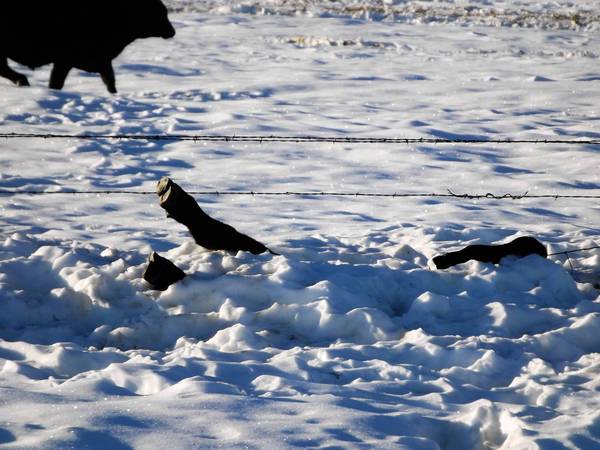It isn’t going to win any awards, but you wouldn’t ask that of a photo taken by the Butte County Sheriff’s Department.
It does highlight important information, however. South Dakota has hit with a blizzard that killed cattle–not all of them, as you can see, or even half of them, but plenty: 80,000 head from 6000 ranches. Because the blizzard came so early, the cattle hadn’t been moved to winter pastures that provide more shelter. Those flimsy strands of barbed wire stretched across the flat terrain capture some of that sense of being trapped on the open range. Because it was so extreme–4 feet of snow and 70 mph winds–the poor beasts were simply overcome with hypothermia and exhaustion. You can sense that from the large animal being all but completely buried by the snow on the plain–not even a drift was needed. And although the sun soon was shining again to melt the snow quickly, the damage had been done, leaving the ranchers little option but to count the dead and get on with the sad, dirty work of disposing of the carcasses.
The photograph’s composition has faults that match the sadness within. The subject is not clear, as one of the cattle is buried and the other blurred. The photo is cropped so closely that it seems too fragmented, with too much left out of the picture. Context here is everything, yet the photo doesn’t provide much in the way of context. Lacking sufficient information about the place or event, the photo seems almost a random example instead of a decisive moment.
So, even despite the stippling of blue and white in the snowfield, it’s not a pretty picture. And that’s another reason why it might be a good photo: it not only communicates some of the facts on the ground, but also captures some of the problems in representing the disaster. Because the disaster in question is not simply due to a snowfall. As the LA Times rightly reported, this also is a story about the government shutdown.
You will not be surprised to learn that, prior to the storm, most residents in the region supported the shutdown. Nor will you be shocked to hear that some of those same people think that the closure should not extend to disaster relief for the region. According to the director of a ranchers association, “One appropriate role for these guys [the federal government] is to lend a hand after disasters like this.”
He is exactly right, of course, but there is a missing piece. You can’t just turn the government on when you need it. Or at least not until human beings are able to perfectly predict the future and the government exists only for you. Until then, wisdom tells us that the unexpected is always happening somewhere, and that just because it wasn’t your turn recently doesn’t mean you’re not due. (South Dakota has received disaster aid before, including for a blizzard in 1996, but apparently that was a long time ago.) Oh, yes, and that everyone is better off if they pool resources to be distributed as needed to prevent or recover from disasters, which is exactly what governments are created to do. That’s why it is important to keep the government open.
But readers of this blog know that. The question I’d like to raise concerns the place for empathy in this debate and in the photo above. Of course, I’m big on empathy and am not above faulting the right for being a few bricks short of a load in that regard. On this issue, however, I’m becoming a conservative–you know, someone who emphasizes accountability and taking personal responsibility for one’s actions. From that perspective, it’s a no brainer: those who support the shutdown and similar coercive, anti-democratic, anti-governmental policies should be the last in line to receive government aid. That’s not playing politics, it’s giving them their wish.
Of course, the minute they are willing to admit that they, too, are “takers,” we can get back to doing things as they ought to be done. But that is only part of the story today. The second question is whether the photo above, or any other for that matter, can induce the level of empathy appropriate to the issue.
What I like about the photo in this regard is that it puts the empathy where it typically would not be otherwise: the cattle. I don’t mean to make light of the economic damage and personal heartache that is involved, or to imply that the ranchers don’t care for their animals; that would be wrong. But the cattle aren’t just economic entities and they did suffer and die miserably. Which actually points to yet another issue: they died, not from any lack of care by the ranchers, but from the unexpectedly extreme weather.
And wouldn’t you know it, such extremes are one of the consequences of global warming. In other words, one of the consequences of climate change that is caused in part by large animal production and denied by far too many Red State voters. Indeed, some of the cattle in South Dakota had been sent up from Texas and New Mexico because of droughts there–and, like heavy rain and snowfalls, droughts are another of the extreme weather conditions that are becoming more frequent due to global warming.
So even if you care only about the cattle, you can’t escape the politics of empathy. The results can be troubling, messy, and depressing, not least because so much has been left outside the frame. But if you let yourself care for those who suffered unnecessarily, you might be prompted to think about larger patterns of cooperation and sustainability.
So take another look: maybe it’s not such a bad picture after all. Certainly when compared to the shutdown itself, which is just plain ugly.

Discussion